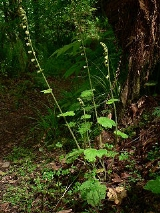
Tellima grandiflora
Encyclopedia
Tellima grandiflora is a herbaceous
perennial plant
of the family Saxifragaceae
.
A herbaceous plant, with rounded leaves, emerging from a rootstock, up to 30cm high. It is evergreen in mild winters. Flowers are borne in spring and early summer, on spikes up to 60cm high. The green calyx is 6–8 mm long; the five flower petals are greenish-white to purple, pinnately divided and spreading. The petals are deeply fringed.
and British Columbia
to northern California
. It is the only species in the genus Tellima. It can be a garden escape and become naturalised in some other areas, e.g. Great Britain
.
This plant, crushed and made into an infusion
, was used by the Skagit
to aid people in sicknesses such as loss of appetite. Ellagitannin
s are chemical compounds that have potential antiviral
activity. Tellimagrandin II
, the first of the ellagitannins, formed from pentagalloyl glucose, is laccase
-catalyzed dimerised to cornusiin E in T. grandiflora.
Herbaceous
A herbaceous plant is a plant that has leaves and stems that die down at the end of the growing season to the soil level. They have no persistent woody stem above ground...
perennial plant
Perennial plant
A perennial plant or simply perennial is a plant that lives for more than two years. The term is often used to differentiate a plant from shorter lived annuals and biennials. The term is sometimes misused by commercial gardeners or horticulturalists to describe only herbaceous perennials...
of the family Saxifragaceae
Saxifragaceae
Saxifragaceae is a plant family with about 460 known species in 36 genera. In Europe there are 12 genera.The flowers are hermaphroditic and actinomorphic...
.
A herbaceous plant, with rounded leaves, emerging from a rootstock, up to 30cm high. It is evergreen in mild winters. Flowers are borne in spring and early summer, on spikes up to 60cm high. The green calyx is 6–8 mm long; the five flower petals are greenish-white to purple, pinnately divided and spreading. The petals are deeply fringed.
Distribution
The plant is a native of moist forests in western North America, from AlaskaAlaska
Alaska is the largest state in the United States by area. It is situated in the northwest extremity of the North American continent, with Canada to the east, the Arctic Ocean to the north, and the Pacific Ocean to the west and south, with Russia further west across the Bering Strait...
and British Columbia
British Columbia
British Columbia is the westernmost of Canada's provinces and is known for its natural beauty, as reflected in its Latin motto, Splendor sine occasu . Its name was chosen by Queen Victoria in 1858...
to northern California
Northern California
Northern California is the northern portion of the U.S. state of California. The San Francisco Bay Area , and Sacramento as well as its metropolitan area are the main population centers...
. It is the only species in the genus Tellima. It can be a garden escape and become naturalised in some other areas, e.g. Great Britain
Great Britain
Great Britain or Britain is an island situated to the northwest of Continental Europe. It is the ninth largest island in the world, and the largest European island, as well as the largest of the British Isles...
.
Uses
It is widely grown in gardens. Different strains have been developed. It seeds itself freely in suitable climates.This plant, crushed and made into an infusion
Infusion
An infusion is the outcome of steeping plants with desired chemical compounds or flavors in water or oil.-History:The first recorded use of essential oils was in the 10th or 11th century by the Persian polymath Avicenna, possibly in The Canon of Medicine.-Preparation techniques:An infusion is very...
, was used by the Skagit
Skagit (tribe)
The Skagit are either of two tribes of the Lushootseed Native American people living in the state of Washington, the Upper Skagit and the Lower Skagit. They speak a subdialect of the Northern dialect of Lushootseed, which is part of the Salishan family. The Skagit River, Skagit Bay, and Skagit...
to aid people in sicknesses such as loss of appetite. Ellagitannin
Ellagitannin
The ellagitannins are a diverse class of hydrolyzable tannins, a type of polyphenol formed primarily from the oxidative linkage of galloyl groups in 1,2,3,4,6-Pentagalloyl glucose...
s are chemical compounds that have potential antiviral
Antiviral drug
Antiviral drugs are a class of medication used specifically for treating viral infections. Like antibiotics for bacteria, specific antivirals are used for specific viruses...
activity. Tellimagrandin II
Tellimagrandin II
Tellimagrandin II is the first of the ellagitannins formed from 1,2,3,4,6-pentagalloyl-glucose. It can be found in Geum japonicum and Syzygium aromaticum . The compound shows anti-herpesvirus properties....
, the first of the ellagitannins, formed from pentagalloyl glucose, is laccase
Laccase
Laccases are copper-containing oxidase enzymes that are found in many plants, fungi, and microorganisms. The copper is bound in several sites; Type 1, Type 2, and/or Type 3. The ensemble of types 2 and 3 copper is called a trinuclear cluster . Type 1 copper is available to action of solvents,...
-catalyzed dimerised to cornusiin E in T. grandiflora.

